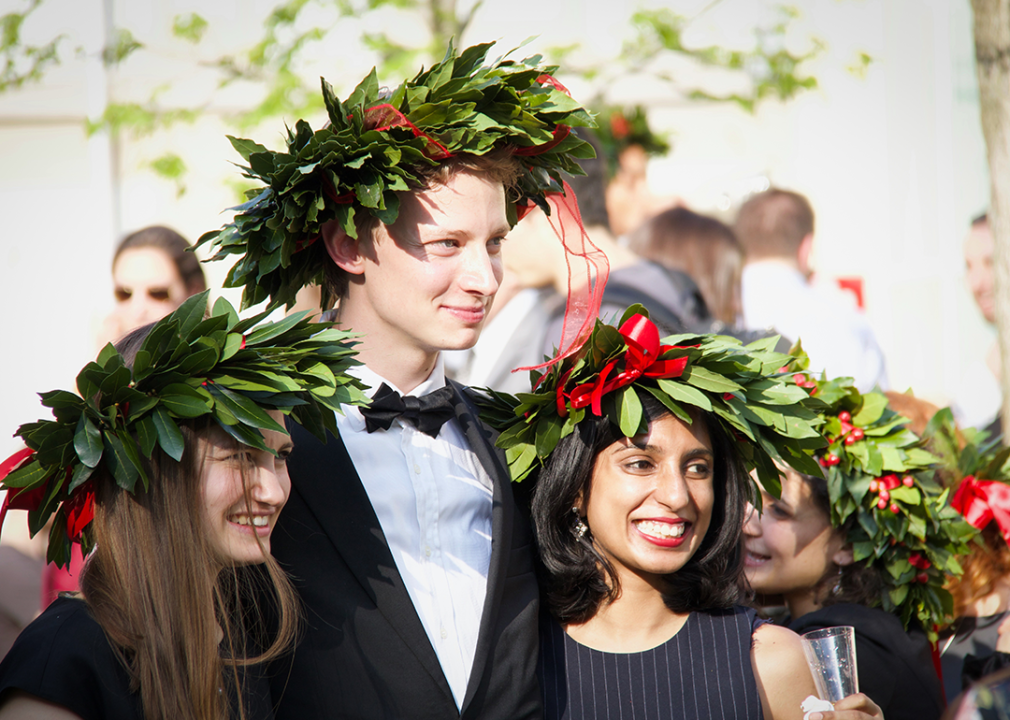What graduation party traditions look like around the world

Rolf_52 // Shutterstock
What graduation party traditions look like around the world
Swedish students celebrating in graduation parade.
Yearbook signings, tearful hugs, a party of a lifetime—these are familiar markers of graduation traditions today. Graduation signals a grand farewell to the past and the start of an entirely new chapter: Who can forget the iconic post-graduation scene in “Grease” where Sandy and Danny literally drive off together?
Around the globe, graduation carries wide-ranging significance; it’s a moment of profound historical and social meaning, though some traditions don’t quite translate across cultural lines. Examining these customs can reveal the histories and relationships associated with traditional education, its role in society, and the expectations for young people.
In South Africa, many see a graduate’s achievements as a collective joy and realization of years of communal struggle and support. Many countries draw from centuries-old tradition and mythology, like Italy, whose graduation ceremonies touch on symbols from Greek myths and Roman lineage.
Peerspace investigated some of the most interesting and meaningful graduation party traditions, using sources like The Guardian, Bustle, and Culture Trip. Read on to see how young people around the world commemorate, revere, and celebrate this affair.
![]()

Imfoto // Shutterstock
Sweden
Students wearing hats celebrate graduation with confetti.
Swedes celebrate “studenten” in some ways reminiscent of a typical celebration in North America: champagne and ceremony. A more unique identifier of a Swedish graduate is the sea-captain-style hat inscribed with their name. Friends and family present giant signs for their graduates usually with large, embarrassing childhood photos.
To top it off, graduates crowd into the bed of a pickup truck and ride around town in a grand parade as townspeople flock to show their support to the graduates. This celebration reflects the vision that graduation is a student’s “last chance” to revel in youth before taking on the responsibilities of adulthood.

Jeffrey Greenberg/Universal Images Group via Getty Images
Argentina
Students participating in graduation celebration in park.
Argentinians take a similarly lighthearted approach to commencement from university. Graduates are not gifted with cards or flowers but with a barrage of eggs, bottles of oil, bags of flour, and anything else—the messier the better! This show of sticky pandemonium is a way to tease and draw playful attention to the graduates.
Oxford in the U.K. shares a similar tradition of showing affection through “trashing” their graduates. As the opulent nature of the trashing tradition has attracted controversy, many have adopted changes to retain the tradition: Today, Oxford requires all “trash” to be biodegradable.

Raffaella Galvani // Shutterstock
Italy
Three graduates wearing laurel wreath celebrate.
Italy may have given the world the reason for the phrase “resting on one’s laurels.” In Italy, graduation continues to be a nerve-wracking affair since it occurs on the same day students present their thesis—and not just to a small panel but to a public audience.
On their big day, students appear before a board of professors, while audience members may come to lend moral support or simply gooseneck. After all the presentations have been completed, the professors announce the students’ performance and present them with a laurel wreath they could proudly wear on their crowns.
Italians adopted the practice from ancient Greece and Rome, where the wreath was Apollo’s symbol and signified victory—a perfect way to celebrate a triumph of the human mind.

Per-Anders Pettersson // Getty
South Africa
Joseph Munyambanza, a student from the Democratic Republic of Congo gets dressed before the African Leadership Academy (ALA) graduation day ceremony in the school in Honeydew, west of Johannesburg, South Africa.
South Africa is one of the most diverse countries in the world. With such cultural and ethnic diversity comes an emphasis on community celebration. When students overcome the persistent adversity created by the country’s history of apartheid to graduate or “matriculate,” families spare no expense in celebrating.
Schools host a “matric dance” similar to an American prom—complete with a limo and red carpet—but preferring more sculpted, design-heavy evening gowns over ball gowns. The community turns out to celebrate the graduates, many of whom are the first to graduate in their families. In Noordgesig, for example, it’s the town’s tradition for the graduates, donning their formal wear, to form a parade of cars around the town square as the entire neighborhood sends them off to celebrate their accomplishment in spite of all odds.

Chung Sung-Jun // Getty Images
South Korea
Students with flowers after graduation ceremony.
South Korea’s traditions have changed markedly over the decades. In the past, students would throw flour and eggs to mark their graduations, but some have taken it to the extreme, causing support for the practice to wane over time.
A more recent graduate can look forward to a meal of jjajangmyeon or black bean noodles. Now a commonplace dish, this fare was an expensive meal served only on special occasions.
Another new tradition is rooted in the practice of the symbolism of standing wreaths, which are typically sent as a grand gesture of celebration often seen in store openings or marriages. Lately, graduates have become a kind of human standing wreaths themselves, with loved ones pinning large, congratulatory messages on their gowns.
Story editing by Carren Jao. Copy editing by Paris Close.
This story originally appeared on Peerspace and was produced and
distributed in partnership with Stacker Studio.
